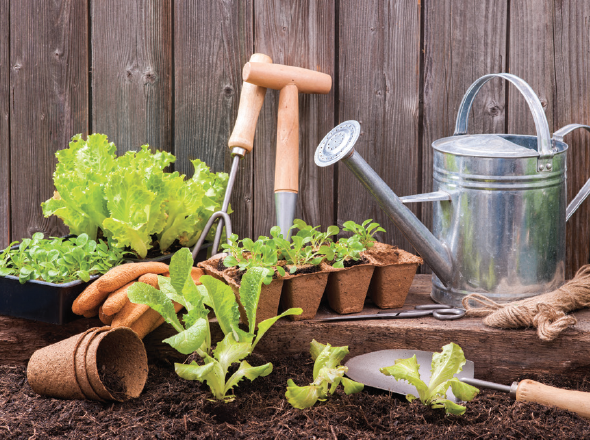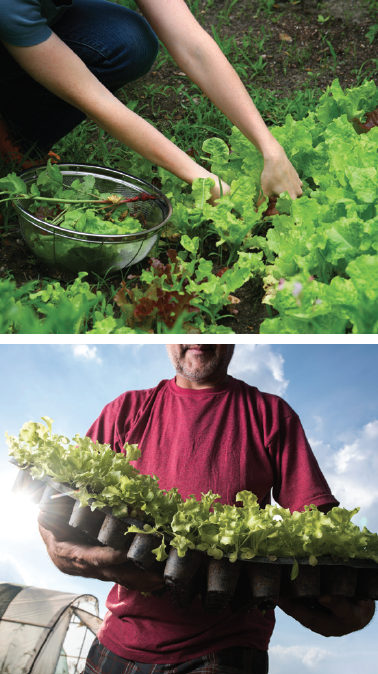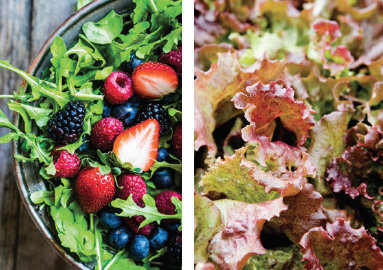Grow Your Own Spring Lettuces

Growing a variety of greens is easy this spring. You will find lettuce seed packets everywhere—from local garden shops and hardware centers to big box stores. Spring lettuces are simple to grow, provide quick results, and are full of vitamins and minerals. And fresh greens have so many uses: They fill the salad bowl, top sandwiches and fill wraps, and provide the base layer on a good plate of salmon, chicken or sliced beef. Here’s how to grow your own spring mix.
Creating a Spring Mix
If you are planting a garden, add several rows of different spring lettuce varieties. These are the leafy varieties that make a salad or sandwich colorful—not the traditional Iceberg lettuce that grows into a big head. It is hard to choose just a few as they have wonderful names to captivate your attention. “Spring Mix” in the grocery store’s produce department becomes exotic when it’s found in seed packets bearing catchy names such as Ruby, Tango and Black Seeded Simpson. You can’t just buy one or two! Read the back of each packet for a description of each variety’s taste, texture and colors. There are so many varieties, and they grow so easily from seed that you will be pleased with the quick results.
 If you aren’t planting a garden or just want some greens within easy reach out your back door, consider planting in pots. A big clay pot with one or two selections, or a group of pots each containing a single type of lettuce will add color and warmth to those early spring days. Lettuces can be planted to fill in between your spring flowers too. Just plant your pansies in a pot with some space between the flowers, make a few holes in the potting soil, and sprinkle in lettuce seeds. Cover with soil, and in about a week, you should see sprouts. Once greens grow to maturity (60 days or less), begin cutting them for your meals. With water and pruning, they will continue to grow and provide you with delicious meals all season long.
If you aren’t planting a garden or just want some greens within easy reach out your back door, consider planting in pots. A big clay pot with one or two selections, or a group of pots each containing a single type of lettuce will add color and warmth to those early spring days. Lettuces can be planted to fill in between your spring flowers too. Just plant your pansies in a pot with some space between the flowers, make a few holes in the potting soil, and sprinkle in lettuce seeds. Cover with soil, and in about a week, you should see sprouts. Once greens grow to maturity (60 days or less), begin cutting them for your meals. With water and pruning, they will continue to grow and provide you with delicious meals all season long.
Lettuces can be planted any time beginning in mid-spring. April is a great time to start, as you don’t have to cover seedlings as often due to fewer frosty nights. Once you plant seeds, all they need is water and sunlight to germinate. These little seeds will grow into beautiful little bunches of lettuce within eight weeks. When the heat of mid-summer arrives, these spring lettuces will begin to dwindle, and you can either plant a new crop in early July (just remember these lettuces will require more care and attention due to heat) or wait until fall to try the autumn varieties.
Lettuces come in so many different types that you should choose selections that offer different colors and textures to make your salads interesting. You want the appeal of various leaves and tastes, so read each seed packet carefully to understand the variety’s characteristics. Some lettuces, such as arugula, are quite bitter and add a spicy element, which can be preferred (or not).
 From Planting to Plate
From Planting to Plate
Most lettuce varieties sprout in a week to ten days, and are ready to eat in five to eight weeks. You want to harvest them when the first leaves mature, and continue to water them well. The lettuce in pots will need more frequent watering, unless the pots are quite large and can retain more water.
Planting in April will give you salads for late May and June. What’s even better is that the more you cut for your salad bowl, the more your plants will grow and produce for you. To harvest, cut the lettuce leaves off one inch above the soil, and they will sprout another crop in no time.
Having fresh greens on hand offers a multitude of quick meal options. Fresh salad is the essence of spring, and planting your own is an easy spring project that can be fun and even involve the whole family. Growing your own greens benefits your garden, your table, and your health, and adds creativity to your meals and your outdoor space.
 Simple Dressings for Seasonal Greens
Simple Dressings for Seasonal Greens
Use an old Mason jar or other recycled glass jar to make dressing. Simply add the ingredients to the jar, screw on the top and shake to blend the ingredients. Here are two simple, fresh variations.
2 tablespoons freshly squeezed lemon juice
2 tablespoons olive oil
1 teaspoon sea salt
½ teaspoon freshly ground black pepper
Freshly grated parmesan cheese
or
2 tablespoons red wine vinegar
2 tablespoons Champagne vinegar
1 cup olive oil
1 teaspoon sea salt
½ teaspoon freshly ground black pepper
Use endive, baby romaine or arugula, or a combination tossed in a salad bowl. Drizzle with dressing, and add your favorite toppings. Rustic bread always makes the spread a little more inviting. Bon appetit!
diy, garden, grow, grow lettus, home gardening, recipe, recipes






